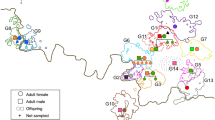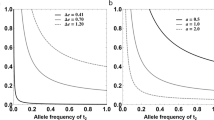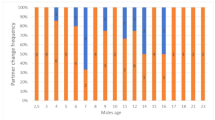Abstract
EXTRA-PAIR copulations (EPCs) seem to be one of the most widespread alternative reproductive behaviours by which male birds can increase their fitness1,2. In many species females actively solicit or freely engage in EPCs3–5, which suggests that they benefit from them. Of the eight hypothetical benefits proposed2,6, the most likely are genetic2. Often females engage in EPCs with more dominant males3,7 or with males with more elaborate ornaments8,9. In species in which paternity was assigned, extra-pair young were divided asymmetrically between males10–12. Here, combining detailed behavioural work with DNA-fingerprinting of an entire population, we present evidence that such an asymmetry is indeed caused by female behaviour, and that 'attractive' males do not suffer lost paternity, survive better and recruit more young. Our results support the genetic quality hypothesis.
This is a preview of subscription content, access via your institution
Access options
Subscribe to this journal
Receive 51 print issues and online access
$199.00 per year
only $3.90 per issue
Buy this article
- Purchase on Springer Link
- Instant access to full article PDF
Prices may be subject to local taxes which are calculated during checkout
Similar content being viewed by others
References
Trivers, R. L. in Sexual Selection and the Descent of Man (ed. Campbell, B. G.) 136–179 (Aldine, Chicago, 1972).
Birkhead, T. R. & Møller, A. P. Sperm Competition in Birds: Evolutionary Causes and Consequences (Academic, London, 1992).
Smith, S. M. Behaviour 107, 15–23 (1988).
Birkhead, T. R. et al. Behav. Ecol. Sociobiol. 27, 315–324 (1990).
Møller, A. P. Behav. Ecol. Sociobiol. 27, 23–29 (1990).
Westneat, D. F. et al. Curr. Ornithol. 7, 331–369 (1990).
Bollinger, E. K. & Gavin, T. A. Behav. Ecol. Sociobiol. 29, 1–7 (1991).
Møller, A. P. Nature 332, 640–642 (1988).
Smith, H. G. & Montgomerie, R. Behav. Ecol. Sociobiol. 28, 195–201 (1991).
Gibbs, H. L. et al. Science 250, 1394–1397 (1990).
Sherman, P. W. & Morton, M. L. Behav. Ecol. Sociobiol. 22, 413–420 (1988).
Westneat, D. F. Behav. Ecol. Sociobiol. 27, 67–76 (1990).
Dhondt, A. A. in Lifetime Reproduction in Birds (ed. Newton, I. A.) 15–33 (Academic, London, 1989).
Dhondt, A. A. Ibis 129, 327–334 (1987).
Birkhead, T. R. et al. Nature 334, 60–62 (1988).
McCullock, P. & Nelder, J. A. Generalized Linear Models (Chapman and Hall, New York, 1983).
Møller, A. P. Behaviour 100, 92–104 (1987).
Berneman, Z. N. et al. FEBS Lett. 255, 226–230 (1989).
Armour, J. A. L. et al. Genomics 8, 501–512 (1990).
Bruford, M. W. et al. in Molecular Genetic Analysis of Populations: A Practical Approach (ed. Hoebul, A. R.) 225–269 (IRL, Oxford, 1992).
Feinberg, A. P. & Vogelstein, B. Analyt. Biochem. 132, 6–13 (1983).
Author information
Authors and Affiliations
Rights and permissions
About this article
Cite this article
Kempenaers, B., Verheyen, G., den Broeck, M. et al. Extra-pair paternity results from female preference for high-quality males in the blue tit. Nature 357, 494–496 (1992). https://doi.org/10.1038/357494a0
Received:
Accepted:
Issue Date:
DOI: https://doi.org/10.1038/357494a0
This article is cited by
-
Sexual selection for both diversity and repetition in birdsong
Nature Communications (2023)
-
Chemical analysis reveals sex differences in the preen gland secretion of breeding Blue Tits
Journal of Ornithology (2022)
-
Neither paternity loss nor perceived threat of cuckoldry affects male nestling provisioning in grass wrens
Behavioral Ecology and Sociobiology (2022)
-
Polygyny is linked to accelerated birdsong evolution but not to larger song repertoires
Nature Communications (2019)
-
An experimental increase in female mass during the fertile phase leads to higher levels of extra-pair paternity in pied flycatchers Ficedula hypoleuca
Behavioral Ecology and Sociobiology (2019)
Comments
By submitting a comment you agree to abide by our Terms and Community Guidelines. If you find something abusive or that does not comply with our terms or guidelines please flag it as inappropriate.



